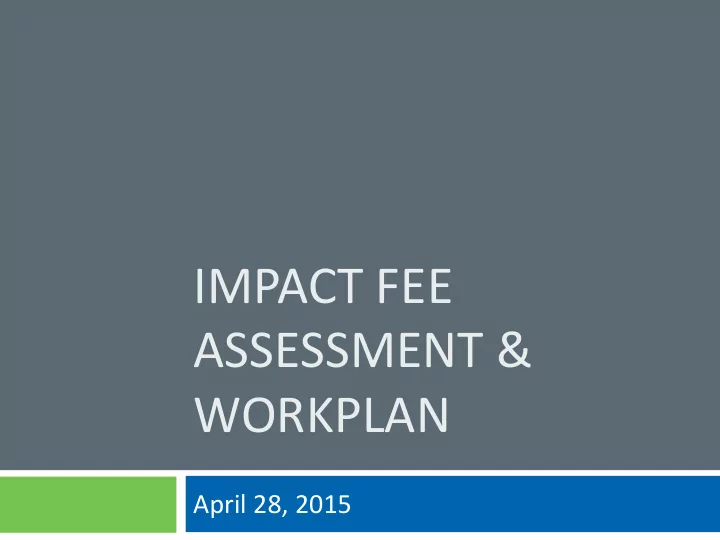

IMPACT FEE ASSESSMENT & WORKPLAN April 28, 2015
Background Seattle is one of the fastest growing cities in the country. As Seattle grows, the city will need to make additional capital investments to support its new growth. Impact fees are a common tool used by many local jurisdictions to help finance capital improvements necessitated by new development and growth. DRAFT Impact Fee Policy Assessment 2
Impact Fee Requirements Under Washington State Law: Impact fees can fund public capital facilities for transportation, park, school, and fire facilities Funded projects must be necessitated by new development and reasonably benefit the new development City must identify the means by which any existing deficiencies will be eliminated within a reasonable period of time Impact fees can be assessed at city-wide, district, or neighborhood scale DRAFT Impact Fee Policy Assessment 3
How Seattle Fund Capital Projects Today SEPA is only existing tool for mitigating impact fee eligible impacts Currently used only for transportation improvements Outside of Major Institutions and SLU Transportation Mitigation Payments program, revenue is small Most improvements are funded through Levies, General Fund, REET, Grants, and Transportation Benefit District DRAFT Impact Fee Policy Assessment 4
Policy Considerations Impact fees can generate revenue proportional to the amount of development occurring in the City (assuming a proven nexus) Impact fees may initially increase costs to renters/tenants/buyer and eventually reduce land values Additional fees could effect cost competitiveness with other cities; however, use of impact fees is common throughout region Affordable housing can be exempted from GMA impact fees Annual impact fee revenue will vary with development cycle DRAFT Impact Fee Policy Assessment 5
Transportation Existing Levy (focused predominately on maintenance) Funding General Fund REET Various State and Federal Grants Transportation Benefits District (focused primarily on transit hours) SEPA Mitigation • Pros Clear connection between growth and additional need • Significant need and limited funding alternatives available • Cons Focus on streets and roads is a challenge • Complicated to develop and maintain Geograph City-wide need, but project list would need to be locally focused y Assessme Recommend to proceed with work plan. nt DRAFT Impact Fee Policy Assessment 6
Parks Existing Parks District (programmed for 6 years, including small Funding acquisition fund) General Fund REET County, State, and Federal Grants Donations Incentive Zoning (generates privately-owned public spaces) • Pros Good alignment between areas of growth and areas of need • Cons Long-term cost of maintenance of new parks must be considered • Land cost is high in growth areas Geograph Might be most viable as a citywide program with district-wide y project lists or could be limited to select urban villages Assessme Recommend to proceed with work plan. nt DRAFT Impact Fee Policy Assessment 7
Schools Funding Levy State and Federal Funding • Pros Could complement next levy to meet school needs. • Cons Current data shows growth in student population is not well aligned with development • Primarily impacts renters who tend to have fewer children • May not be able to demonstrate need with existing levy in place Geograph Determining geography will be challenging since current data y shows areas of growing student population are not aligned with new development Assessme Given current analysis of growth patterns, impact fee may be nt minor source of funds compared to levy and may not be the right tool for addressing need. But to ensure potential is fully understood, recommend engage with Seattle Schools to discuss possibilities and refine analysis. DRAFT Impact Fee Policy Assessment 8
9
10
Fire Existing Levy (previous Fire Facilities levy expired; new Public Safety levy Funding under consideration) General Fund (minimal funding for capital facilities) • Pros Could complement future levy • Cons Need of new stations or additional engines is minimal Geograph South Lake Union is only area that has been identified as needing y a new or expanded fire station Fire’s needs are primarily operational and major maintenance, Assessme nt which cannot be addressed through an impact fee. Recommend NOT to proceed. DRAFT Impact Fee Policy Assessment 11
Potential Cumulative Impacts Impact fees in other cities tend to be in the following range of costs: Transportation: $1-5/sq ft Parks: $1-3/sq ft Schools: $2-4/sq ft (residential only) Fire: $0.2-0.8/sq ft Additionally, the City is considering linkage fees: Affordable Housing: Council Recommendation of $4-18/sq ft Child Care: Nexus study suggests maximum of $1-4/sq ft The total cost of new development tends to be $300-400/sq ft. Consequently, the combined impact of implementing all these options could be a 3-9% increase in the cost of development. DRAFT Impact Fee Policy Assessment 12
13
Recommend
More recommend